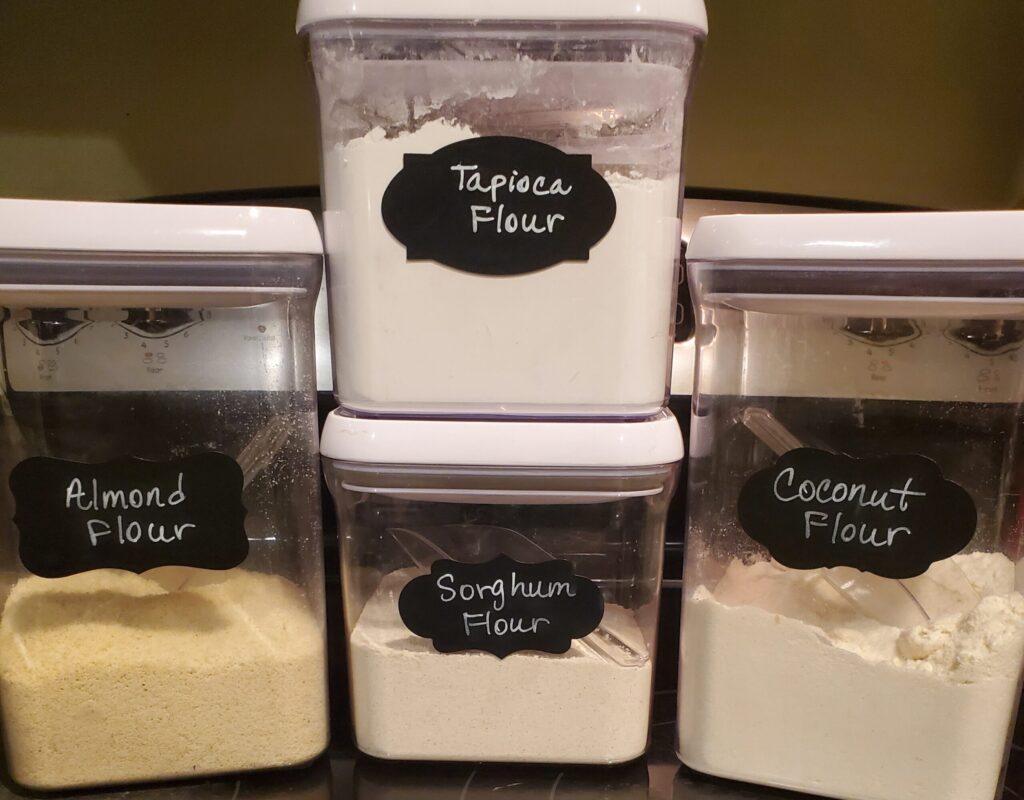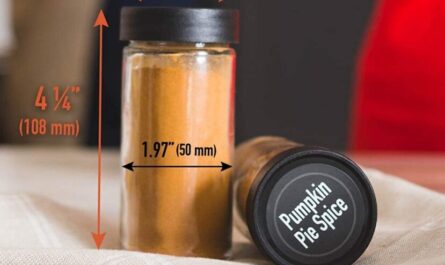Along with cutting back on processed sugar in your diet, one of the biggest challenges with the low carb, high fat keto “way of eating” (woe) is removing flour-based foods like bread, crackers, and pasta from your diet. Thankfully, there are still several options for keto cooking and baking. While some of the flours we list in this article ideally cannot be considered as perfect 1-to-1 substitutions for wheat flour, there are still endless possibilities and recipes available for making keto meals, desserts, breads, and batters for you to enjoy low carb versions of some of your favorite high carb foods. Below is a list of 12 Recommended Keto-Friendly Flours that we keep a steady supply of within our own pantry.
While most of these 12 recommended keto-friendly flours contain some carbs, they are also rich in fiber and low in “net carbs.” Net carbs refers to the number of grams of carbs in a food once the total fiber grams and alternative sweeteners have been subtracted. Fiber is a type of indigestible carb, so the carbs from fiber don’t have to be included in your daily carb count if you are infact counting carbs (2Trusted Source).
Listed below are 12 recommended keto-friendly flours, how to use them, the manufacturers’ storage recommendations, and some of our favorite recipes that contain them.
1. Almond flour
Of the 12 recommended keto-friendly flours, Almond flour is probably the most widely used keto flour substitute. It’s made simply from blanched and finely crushed almonds, and it is extremely low in carbs, containing 80 calories, 3 grams of total carbs, 2 grams of fiber, 3 grams of protein, and only 1 gram of net carbs per 2-tablespoon (14-gram) serving (3Trusted Source).
You can use almond flour as a 1-to-1 substitute for wheat flour in baking, but baked goods containing almond flour can tend to be a little on the spongy side. Regardless of this, we have experimented with a plethora of very tastey recipes in our kitchen and have made many delicious and enjoyable dishes. Almond flour can be used as a breading for fried, air-fried, or baked foods, but its main use is for keto baked goods, such as cookies, cakes, sweet breads, waffles, pancakes, pie crust, etc.
Storage Recommendations: Almond flour is not like traditional flours, so it is best kept stored in an air tight container in a fridge, freezer or cool pantry in order to keep it from going bad. Generally, an unopened almond flour bag can be good for 2-4 months in the pantry, and about 6-12 months in a fridge.
Best for: baking, breading
Try: Organic Almond Flour
Recipes
- Awesome Keto Pumpkin Breadvery
- Gluten Free Apple Cinnamon Bread
- Absolutely Scrumptious Keto Brownies
- The Best Keto Cornbread
2. Coconut flour
Coconut flour is a very fine, powdery flour made from coconut flesh. Its mild coconutty taste works in most desserts, which is what it’s most commonly used for. Next to almond flour, it’s one of the most popular and commonly used keto flours. Coconut flour has been widely favored as an ideal low carb substitute flour for baking cakes, brownies and muffins if there’s a desire for your baked products to have a more moist consistency.
A 2-tablespoon (15-gram) serving contains 60 calories and provides 9 grams of carbs, 5 grams of fiber, 3 grams of protein, and 4 grams of net carbs (4Trusted Source).
In most recipes, you need only a small amount of coconut flour. It absorbs lots of liquid, so using it as a 1-to-1 substitute for flour will result in an extremely dry product unless you add extra liquid ingredients.
For this reason, this flour is best used in recipes that were specifically developed for coconut flour.
It also makes an excellent thickener, but keep in mind that you may taste that hint of coconut.
Storage Recommendations: When stored properly, coconut flour will last for up to two years. The best way to store coconut flour is in an airtight container in a cool, dark place, such as the pantry, fridge, or freezer.
Best for: baking, desserts, thickening
Recipes
- Awesome Keto Pumpkin Bread
- Gluten Free Apple Cinnamon Bread
- Absolutely Scrumptious Keto Brownies
- The Best Keto Cornbread
3. Gluten-Free All-Purpose Baking Flour
This Gluten-Free All-Purpose Baking Flour has a superb blend of ingredients that taste great, and it substitutes 1-for-1 when a recipe calls for an all-purpose flour. It is also great for anyone who suffers from Celiac disease.
Try: Gluten-Free All-Purpose Baking Flour
Recipes
3. Chia flour
Chia flour is made from ground chia seeds, which are loaded with soluble fiber. Because of this, chia absorbs a ton of water and moisture, just as coconut flour does.
A 2-tablespoon (12-gram) serving of ground chia seeds contains 60 calories, 3 grams of protein, 5 grams of total carbs, 5 grams of fiber, and 0 grams of net carbs (5Trusted Source).
Chia flour isn’t commonly used in keto baking recipes. You’ll typically mix it with other flours when baking.
If you’re looking for dessert ideas outside of baking, though, both whole chia seeds and ground chia seeds can be used to make an excellent low carb, high fiber pudding.
Storage Recommendations: Keep ground chia seeds (chia flour) in a glass or plastic storage container with a tight-fitting lid. The flour may be stored in a cool, dry place such as a pantry, or in the refrigerator. Chia flour, like chia seeds, may be stored for months without going rancid.
Best for: baking
Try: Organic Chia Flour
4. Flaxseed meal
Flaxseed meal is made from ground flaxseeds, which are low in carbs — containing 70 calories, 4 grams of total carbs, 3 grams of protein, and 0 grams of net carbs per 2-tablespoon (14-gram) serving — and rich in potentially anti-inflammatory omega-3 fats (6Trusted Source, 7Trusted Source).
Like chia flour, it absorbs a great deal of liquid, so it’s usually mixed with other keto-friendly flours in baking. However, flaxseed meal is commonly used on its own or with chia seeds to make low carb flaxseed crackers.
Storage Recommendations: Keep your flaxseeds fresher longer by keeping them in an airtight container. Whole or ground, it’s not required to be stored in the fridge. A cool, dark pantry should be fine. Though just as storing nuts in the fridge increases their shelf life, the same goes for flaxseeds and flaxseed meal.
Best for: crackers
5. Psyllium husk powder
Psyllium husks, which are rich in fiber, are the key ingredient in many fiber supplements. They absorb water and swell up, adding a bit of structure to foods that contain them.
One tablespoon (9 grams) contains 8 grams of total carbs, 6 grams of fiber, and 2 grams of net carbs (8Trusted Source).
In my experience, adding a little bit of psyllium husk powder to keto recipes made with almond flour provides a more bread-like texture, but, again, it’s typically mixed with other flours.
Storage Recommendations: Store psyllium husk powder in your pantry, in cool, dark place. Psyllium husk can be stored for up to 24 months if it is kept in an airtight container.
Best for: baking
Try: Psyllium Husk Powder
Recipes
6. Oat Fiber
Oat fiber is made from the crushed husks of oats. It’s a common addition to keto baked goods because it provides some structure and bread-like consistency. One teaspoon (4 grams) contains 4 grams of total carbs and 1 gram of net carbs.
As with many other flours on this list, recipes don’t often use oat fiber as a standalone flour but instead use it in combination with other low carb flours. Oat Fiber can be used in recipes to increase a food’s fiber content; use in breads, cookies, muffins, rolls and more.
Storage Recommendations: Stores for 2 years in a sealed bag under ideal storage conditions (cool, dry place).
Best for: baking
Try: All Natural Gluten Free Oat Fiber
Recipes
7. Oat flour
Oat flour is a whole-grain alternative to wheat flour. Oat flour is made from the crushed husks of oats.
Oat flour does not rise the same way that wheat flour does. You will need to use extra baking powder or another leavening agent to ensure the proper rise of your end product.
Try adding 2.5 teaspoons (12.5 grams) of baking powder per cup (92 grams) of oat flour.
If you’re using oat flour due to a gluten allergy or intolerance, be mindful that oats are often contaminated with gluten during processing. To avoid this, ensure that you’re buying certified gluten-free oats.
Storage Recommendations: Oat flour will last about 3 months stored in a cool area in your pantry or up to 6 months when stored in the freezer. Make sure you’re placing the oat flour in a sealed plastic bag or an airtight glass container, such as a large mason jar or Tupperware.
Best for: baking
Try: Organic Whole Grain Oat Flour
Recipes
8. Lupin flour
Lupin Flour is made from sweet lupin beans, a close relative to peanuts and soybeans. It’s commonly used in gluten-free pasta and is a key ingredient in several keto-friendly pasta recipes. Add a small scoop or two in your smoothie, shake or yogurt for an added boost! Lupin Flour can also be used to make pasta, bread, cakes, cookies, tortillas, pie crusts, pancakes, waffles, and so much more!
A 1/4-cup (28-gram) serving provides 74 calories, 12 grams of total carbs, 11 grams of fiber, 12 grams of protein, and 1 gram of net carbs. It’s also naturally high in protein. (10Trusted Source)
Although it’s most frequently used for pasta, many baking recipes feature a mixture of lupin flour and coconut flour or almond flour.
Storage Recommendations: Like many alternative flours, lupin flour is best stored in an airtight container in the fridge, or in the freezer. If refrigeration or freezing is not available, then store in a cool, dark cupboard, and use within its “use by” date.
Best for: baking, pastas
Try: Premium Lupin FLour
Recipes
9. Pork rind crumbs
Though it may sound weird at first, crushed pork rinds (fried pork skins) make a great breading for fried, air-fried, or baked keto foods, since flour and cornmeal are off the table due to their carb content (1Trusted Source, 11Trusted Source).
You can buy pork rind crumbs or make your own using store-bought pork rinds.
Pork rind crumbs are totally free of carbs and high in fat and protein, so it’s ideal for keto. It’s a great alternative to breadcrumbs as well, so you can use it to make cornbread, meatballs, meatloaves, and many other recipes that are typically high in carbs (12Trusted Source).
Storage Recommendations: Pork rind crumbs have a shelf life ranging from nine months to two years. This means that the crumbs will stay fresh and edible for this amount of time, provided that they are stored in an airtight container in a cool, dry place. After two years, the crumbs may start to lose their flavor and become less crunchy.
Best for: baking, breading, meatballs
Try: Pork Rind Crumbs
Recipes:
10. Sorghum Flour
Sorghum flour grains are unrelated to wheat, so they are suitable for those with celiac disease or a gluten intolerance. Traditionally, this gluten free flour has been used to create pancakes, porridges, and flatbread such as jowar roti in India. It can also substitute for other grains in cakes, cookies, breads and muffins. Due to its mild taste and smooth texture, sorghum flour is a great choice to replace wheat flour in sweet breads, savory breads, cookies and more . Increase daily intake of whole grains the easy way: add 15% to 20% sorghum flour to your flour mixes to make delicious breads, cakes and cookies.
Storage Recommendations: Sorghum flour should be stored in an airtight container in a cool, dry place for up to 12 months from date of production. Others recommend that it can also be stored in the refrigerator for up to 3 months or freeze for up to 6 months.
Best for: baking
Try: Gluten Free Sorghum Flour
Recipes
Gluten Free Apple Cinnamon Bread
11. Tapioca flour
Tapioca Flour is extracted from cassava root, a tuber native to South America. It’s naturally grain and gluten-free, so it can serve as a wheat substitute in cooking and baking for people who are on a gluten free diet. Tapioca flour, used sparingly due to it’s carb content, is often combined with other flours and can be used in bread recipes. It can also be used as an excellent thickener in soups, sauces and gravies as a replacement for cornstarch in keto-friendly recipes.
Storage Recommendations: Like other starches tapioca flour will store well in a cool dark place for up to year. Keep in an airtight container so no moisture can get in.
Best for: baking, cooking
Try: Organic Gluten Free Tapioca Flour
Recipes
Gluten Free Apple Cinnamon Bread
12. Wheat Gluten
Wheat Gluten is derived from the protein found in wheat. It gives shape, volume and elasticity to baked goods. It can also be added to any bread recipe to enhance texture and protein content.
Wheat gluten is often used by commercial bakeries to produce light textured breads, and can easily put the home bread baker on a par with the professionals. Wheat gluten is also a staple ingredient for meat and meat substitutes. It acts as a binder for meatballs, meatloaf, veggie burgers and tofu alike.
Wheat gluten is often listed as “optional” in baking recipes, but it’s a helpful ingredient to have on hand. Since it’s a concentrated wheat protein, just a tablespoon or two of wheat gluten in your next loaf of bread can improve its elasticity and create a better crumb and chewiness in the final product. The protein boost provided by wheat gluten produces a stronger gluten network, which means the dough becomes more elastic, which in turn results in crispier crusts, chewier bread, a larger crumb, and more pronounced oven spring.
Storage Recommendations: Wheat Gluten will store for 7 to 10 years in a sealed #10 can (oxygen absorber included) under ideal storage conditions (cool, dry place). Once opened, it has an average shelf life of 6 to 12 months
Best for: baking
Try: Organic Wheat Gluten



